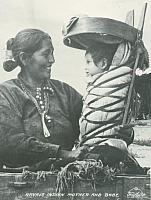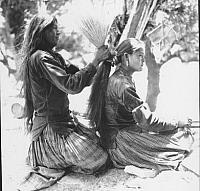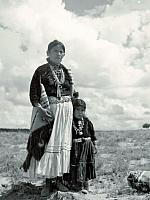Teenage Pregnancy in Navajo Nation
Teen Pregnancy Causes and Effects in Navajo Nation
Emily Van Dusen
A Brief Introduction
Teenagers in the Navajo tribe have among the highest rates of teenage pregnancy, they are about 15.8% higher than the national average, and the lowest rates of contraceptive use in the United States. 65% of males, and 57% of females report having sexual intercourse by/before the 12th grade, but only half of those reporting having sex report always using contraceptives. This can have extreme consequences, such as educational deficits, economic strain, and can cause reservations to have a higher concentration of poverty, or extreme poverty.

What is sexual education like in reservation schools?
Sexual education is not a subject that is often broached by reservation schools, or even passed on from mothers to daughters or fathers to sons. Off-reservation schools are especially insensitive to Indigenous women, and often, dating Indigenous women in high school is viewed as a sexual activity, rather than a romantic one. The Navajo reservation is the state’s highest ‘out of wed-lock’ birth location (Dehyle, 1995).
Typically, traditional Native American cultures tended to be egalitarian, and often marriage is viewed as being neither religious, nor civil. Marriage seems to be much more open and even celebratory of/about members sexuality (Traditional Views of Sex and Marriage). HIV rates are often higher among Indigenous Peoples than white people, but are still relatively low overall. Although relatively low as well, gonorrhea was the highest rate, 5x more prevalent in Indigenous women than in white women, and 3.9x more prevalent in men. Chlamydia is the second highest rate, being overall 4x more prevalent than in Caucasian people (STI Infection Rates).

What are the effects of a teenage pregnancy on the mother/daughter relationship?
Navajos trace their descent matrilineally, so there is a strong and important relationship between a mother and daughter, and even a grandmother and granddaughter. In most Navajo myths, women are the most powerful figures, and motherhood is often depicted in these myths, as it is highly valued within Navajo belief systems (Dalla & Gamble, 2000).
It is thought that the prevalence of teenage pregnancy on the Navajo reservation could be caused by this, as the maternal role is very strongly ingrained into Navajo culture. A study in 2000 by Dalla and Gamble, seven Navajo girls who live on the reservation were interviewed, and the majority of those girls reported that they were in long term relationships with the father of their baby. Half the girls in the study expressed that they felt a strong commitment to one role or the other, either maternity or adolescence, and the other half expressed role duality, or a desire to integrate both roles. This study also examined how this effected the girl’s relationships with their mothers, and four of the seven mothers were highly supportive of their daughters pregnancies, and one of the seven parents stepped in as a surrogate parent in place of their daughter. There was one negative effect on the mother-daughter relationship that was noted in the study, the mothers tend to be very critical of their daughter’s parenting, which can cause serious strains on the relationship.
The Native American Teen Pregnancy Prevention Resource Center says that having a child at age 18 or younger is common, and cites low income levels, low educational attainment, and membership in a marginalized group as factors that place Indigenous women at risk. The resource center also cites that a history of sexual abuse is also linked to evaluate a young woman’s risk for teen pregnancy. There is a 36% prevalence rate of sexual abuse in the Navajo community, and around 26% of teens who were sexually abused became pregnant as teens (Early Childbearing among Native Americans).

What are the effects of a teenage pregnancy on the community?
While teenage pregnancy may not have too many bad effects on the relationship between mothers and their daughters, there are a plethora of effects it can have on the community. There is a relatively high concentration of poverty or extreme poverty on reservations due to lack of jobs, and a lack of space due to overpopulation. A study done by the U.S. Department of Agriculture showed that Indigenous teenage mothers started prenatal care later than their peers, and were also found to have a higher rate of substance abuse during pregnancy, along with being at a higher risk for developing diabetes during pregnancy.
Contraceptive use among Indigenous Youth, and other statistics
There is also a distinct lack of contraceptive use among Indigenous teens, mostly due to a lack of sexual education in high schools. The Indigenous population shows some of the lowest documented rates of contraceptive use in the United States, with a recent study showing the 65% of males and about 57% of females report that they have had sexual intercourse by the 12th grade. Only around 40-50% of those reporting also report that they use contraceptives every time, and more than 50% of females reported having had sex without contraceptives between their 7th and 9th grade years. Information from the Bureau of Indian Affairs schools show that high school students from reservation schools are more likely to have had sexual intercourse when compared to national rates of high school students. Overall, Indigenous youth are significantly more likely to have sexual intercourse at a younger age than peers and are far less likely to have used contraception the last time they had sex (than compared to peers).
Information Sources
Dehyle, D., Margonis, F. (June 1995). Navajo Mothers and Daughters: Schools, Jobs, and the Family. Anthropology & Education Quarterly (Vol. 26, Issue 2). https://doi.org/10.1525/aeq.1995.26.2.05x1252d
Dalla, R. L., Gamble, W. C. (March 2000). Mother, Daughter, Teenager- Who Am I? Perceptions of Adolescent Maternity in a Navajo Reservation Community. Journal of Family Issues (Vol. 21, Issue 2, Pages 225-245). https://doi-org.proxy1.cl.msu.edu/10.1177/019251300021002005
Dawes, T., Gray, T., Nawrocki, R. Views of Sex & Marriage. Retrieved from: https://capacitybuilders.info/prevention/sex-marriage-views.php
Dawes, T., Gray, T., Nawrocki, R. Early Childbearing Among Native Americans. Retrieved from: https://capacitybuilders.info/prevention/early-childbearing.php
Dawes, T., Gray, T., Nawrocki, R. STI Infection Rates. Retrieved from: https://capacitybuilders.info/prevention/sti-infection-rates.php
Allen Cheadle, David Pearson, Edward Wagner, Bruce M. Psaty, Paula Diehr and Thomas Koepsell Public Health Reports (1974-), Vol. 109, No. 3 (May - Jun., 1994), pp. 405-413. Association of Schools of Public Health
The National Campaign to Prevent Teen and Unplanned Pregnancy. "American Indian/Alaska Native Youth and Teen Pregnancy Prevention". (accessed February 20, 2018)
Rochelle L. Dalla and Wendy C. Gamble Family Relations , Vol. 46, No. 2 (Apr., 1997), pp. 113-121 Published by: National Council on Family Relations
Brian Joseph Gilley Culture, Health & Sexuality , Vol. 8, No. 6 (Nov. - Dec., 2006), pp. 559-570 Published by: Taylor & Francis, Ltd.
S. Edwards Family Planning Perspectives , Vol. 24, No. 4 (Jul. - Aug., 1992), pp. 189-191 Published by: Guttmacher Institute.
National Women’s Law Center “POVERTY AMONG WOMEN AND FAMILIES, 2000-2010: EXTREME POVERTY REACHES RECORD LEVELS AS CONGRESS FACES CRITICAL CHOICE.” Rep. National Women's Law Center, Sept. 2011. Web. 8 Feb. 2018.
United States Department of Agriculture. "THE CHARACTERISTICS OF NATIVE AMERICAN WIC PARTICIPANTS, ON AND OFF RESERVATIONS." United States Department of Agriculture Food and Nutrition Service.
Photo Sources
Smithsonian National Anthropological Archives. Photos of Women of the Navajo (Diné) Nation. Navajo woman with son. Retrieved from: https://navajopeople.org/photos/index.php/Navajo-Woman
Utah State Historical Society. Photos of Women of the Navajo (Diné) Nation. Mother-daughter hair. Retrieved from: https://navajopeople.org/photos/index.php/Navajo-Woman
Smithsonian National Anthropological Archives. Photos of Women of the Navajo (Diné) Nation. Mother and son in a field. Retrieved from: https://navajopeople.org/photos/index.php/Navajo-Woman